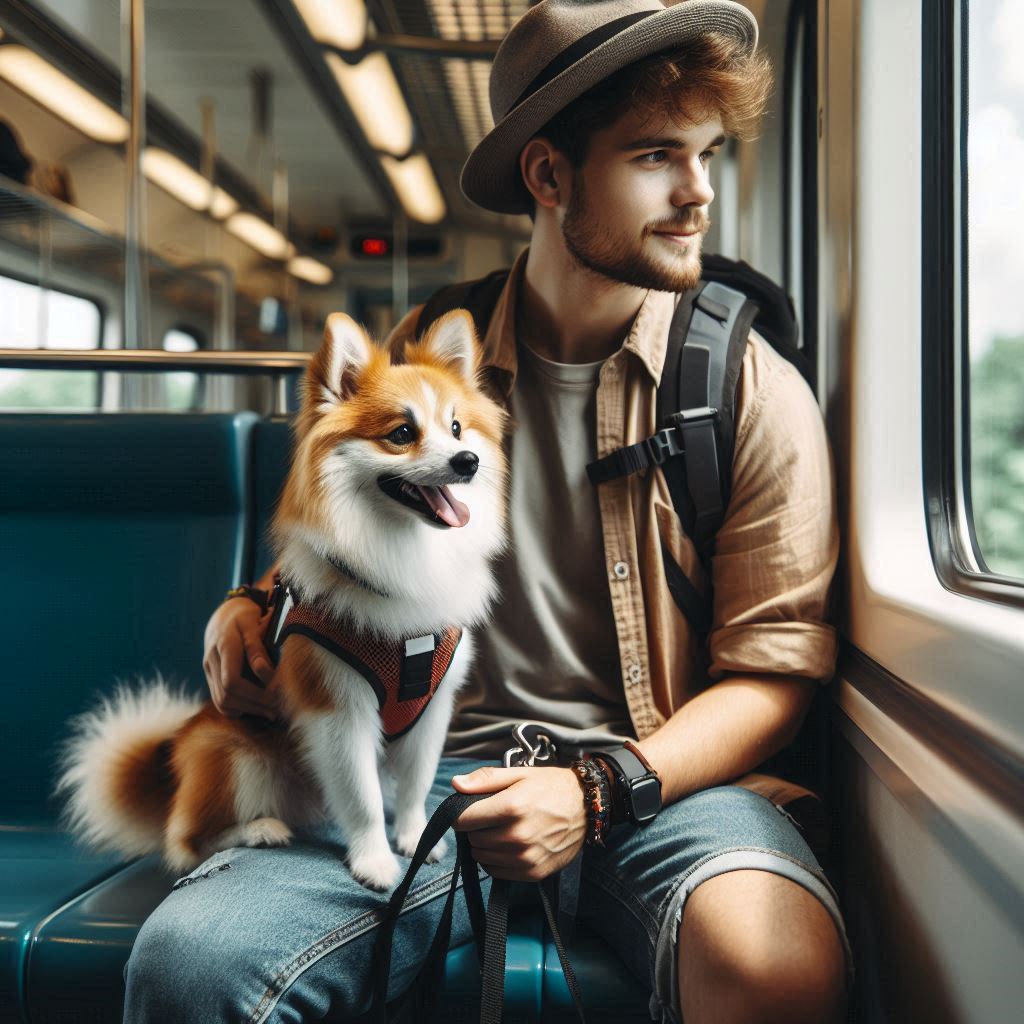Understand how traveling with your pet while heading out on holiday can impact your holiday either negatively or positively.
Taking Your Furry Friend Further: The Ins and Outs of Traveling Overseas with Your Pet
For many pet owners, their furry companions are more than just animals; they're cherished family members. The thought of leaving them behind during a dream vacation can be heart-breaking. Fortunately, for adventurous pet parents, traveling overseas with your pet is no longer an impossible dream. However, before booking flights and packing pet passports, careful consideration is crucial. Here's a comprehensive guide to navigating the complexities of taking your pet on an overseas adventure:
Is Your Pet Up for the Adventure?
Not all pets are suited for international travel. Consider these factors before making a decision:
· Age and Health: Very young puppies or senior pets with health concerns might not handle the stress of travel well. Consult your veterinarian to ensure your pet is healthy enough for the journey.
· Temperament: Anxious or easily stressed pets might struggle with the unfamiliar sights, sounds, and smells of a new environment. Consider your pet's personality and assess if they can adapt to the travel experience.
· Breed: Certain breeds like brachycephalic dogs (pugs, bulldogs) can have breathing difficulties during air travel. Research breed-specific considerations for overseas travel.
Planning and Preparation: Ensuring a Smooth Journey
If you decide your pet is a good candidate for international travel, meticulous planning is essential:
· Microchipping and Vaccinations: Ensure your pet is microchipped and has all the necessary vaccinations updated and documented in a pet passport. Research the specific vaccination requirements for your chosen destination well in advance, as they can vary significantly by country.
· Pet Airline Regulations: Different airlines have varying pet transport policies. Research airline-specific regulations regarding pet size, weight restrictions, container requirements, and in-cabin versus cargo hold transport options. Book your pet's flight well in advance, especially during peak travel seasons.
· Pet Travel Documents: Obtain the necessary health certificates and import permits from both your home country and the destination country. This process can take time, so start planning several months before your travel date.
Making the Journey Comfortable: Prioritizing Your Pet's Well-being
· Pet Carrier Selection: Invest in a comfortable, airline-approved pet carrier that provides your pet with enough space to stand up, turn around, and lie down comfortably. Familiarize your pet with the carrier well before travel.
· Comforting Your Pet: Line the carrier with familiar bedding and include a favorite toy or chew item to provide comfort during the trip. Consider pheromone sprays or calming aids recommended by your veterinarian for anxious pets.
· Hydration and Feeding: Ensure your pet has access to fresh water during the journey. Consult your veterinarian regarding appropriate feeding schedules during travel to avoid digestive issues.
Navigating Arrival and Beyond: Ensuring a Smooth Transition
· Airport Procedures: Be prepared for additional time at the airport for pet screening and customs clearance. Familiarize yourself with the arrival procedures at your destination to avoid any delays.
· Quarantine Regulations: Some countries impose mandatory quarantine periods upon arrival. Research these requirements for your chosen destination and factor in any associated costs. Consider alternative destinations if quarantine is a non-starter for you.
· Pet-Friendly Accommodations: Not all hotels or rental properties are pet-friendly. Make sure your chosen accommodation allows pets and inquire about any pet fees or restrictions.
The Advantages and Challenges: Weighing the Options
Traveling with Your Pet:
· Shared Experiences: Creating memories with your furry companion can be incredibly rewarding. Sharing adventures strengthens the bond between you and your pet.
· Peace of Mind: Knowing your pet is by your side can alleviate the stress of leaving them behind.
Leaving Your Pet Behind:
· Reduced Stress: Traveling with a pet can be stressful for both you and your pet. Leaving them in familiar surroundings with a trusted pet sitter could be a more comfortable option.
· Financial Considerations: The cost of pet travel, including airline fees, pet passports, and quarantine charges, can be significant.
The Final Decision: Tailoring the Choice to Your Needs
The decision of whether or not to take your pet on an overseas adventure is a personal one. Carefully weigh the advantages and challenges, considering your pet's temperament, travel regulations of your chosen destination, and your own financial constraints.
Ultimately, the goal is to create a positive experience for both you and your furry friend.
Ultimately, the goal is to create a positive experience for both you and your furry friend. Whether you decide to embark on an international adventure together or opt for a well-planned staycation with a trusted pet sitter, prioritizing your pet's well-being is paramount.
Making the Choice: Tailoring the Trip to Your Pet's Needs
If you've determined your pet is a good candidate for international travel, here are some additional considerations to ensure a smooth and enjoyable journey:
· Destination Selection: Choose a pet-friendly destination with plenty of green spaces, walking paths, and pet-welcoming establishments. Research any restrictions on pet access to beaches, parks, or public transportation.
· Activities and Excursions: Plan activities suitable for your pet's energy level and temperament. Prioritize outdoor adventures like hikes or walks in nature trails, keeping in mind the local climate and ensuring your pet doesn't overheat.
· Packing for Your Pet: Pack essential pet supplies like food, medications, water bowls, leashes, waste disposal bags, and a first-aid kit. Bring familiar toys and bedding to create a sense of comfort in unfamiliar surroundings.
Travel Day Considerations: Ensuring a Smooth Flight
· Airport Arrival: Arrive at the airport well in advance to allow for additional time for pet check-in and security screenings.
· Hydration and Comfort: Offer your pet water throughout the travel day, but avoid overfeeding them before the flight to prevent nausea. Provide a comfortable bed or pad inside the carrier and ensure proper ventilation.
· Minimize Stress: During layovers, take your pet for short walks outside the carrier to allow them to relieve themselves and stretch their legs. Talking to your pet in a calming voice and offering reassuring pats can help minimize their anxiety.
Upon Arrival: Adapting to a New Environment
· Gradual Acclimatization: Allow your pet time to adjust to the new environment. Let them explore the surroundings on a leash and at their own pace. Maintain their familiar routine as much as possible, including feeding times and walks.
· Local Veterinarian Contact: Research and locate a reputable veterinarian in your destination city in case of emergencies. Pack any medical records or prescriptions your pet might need.
· Pet-Friendly Activities: Plan activities that cater to both you and your pet. Look for dog-friendly beaches, restaurants with outdoor seating that allows pets, or parks with designated off-leash areas.
The Comfort of Home: Leaving Your Pet Behind
The decision to embark on an overseas adventure can be clouded by the worry of leaving your beloved furry friend behind. Visions of them pacing anxiously or whimpering for their favorite human can make the prospect of an exciting vacation feel incomplete. However, in some cases, prioritizing your pet's comfort at home might be the most responsible and loving choice. Here's a look at strategies for ensuring your pet thrives while you explore the world:
Understanding Your Pet's Needs:
Before making a decision, consider your pet's temperament and well-being:
· Age and Health: Very young puppies or senior pets with health concerns might struggle with the disruption of a change in routine or the stress of a new caregiver. Consult your veterinarian to assess if your pet is mentally and physically capable of handling a long period without your presence.
· Temperament: Anxious or easily stressed pets might not cope well with the absence of their primary caregiver. Consider their past behavior when left alone or boarded. Have they exhibited signs of separation anxiety in the past?
· Adaptability: Some pets adapt readily to new environments and caregivers. Evaluate your pet's past experiences with pet sitters or boarding facilities.
Finding the Right Caregiver: Peace of Mind While You're Away
If leaving your pet at home is the chosen path, meticulous selection of a caregiver is crucial:
· Trusted Pet Sitter: Choose a reliable and experienced friend, family member, or professional pet sitter who understands your pet's needs and routine. Someone with experience caring for pets with similar temperaments is an ideal choice.
· Meet-and-Greet Sessions: Schedule multiple meet-and-greet sessions before your trip to allow your pet to become comfortable with the caregiver. This helps establish trust and reduces stress when you're finally gone.
· Clear Communication: Communicate your pet's feeding schedule, walking routine, medication needs (if any), and preferred playtime activities. Provide detailed written instructions and leave emergency contact information for both yourself and your veterinarian.
Replicating Routine for Comfort:
Stability in Familiarity:
· Maintaining Routine: As much as possible, maintain your pet's regular feeding schedule, playtime, and walks even in your absence. This sense of normalcy can provide comfort and reduce anxiety.
· Familiar Surroundings: Keeping your pet in their familiar home environment allows them to feel safe and secure. Many pets find new environments overwhelming and unsettling.
· Beloved Items: Provide familiar toys, bedding, and blankets that hold your scent. These familiar items offer a sense of comfort and security in your absence.
Enhancing the Experience with a Qualified Caregiver:
· Professional Care: For pets that thrive on interaction, consider hiring a professional pet sitter who can provide regular visits throughout the day. These visits offer playtime, companionship, and ensure timely feeding and waste disposal.
· Structured Activities: Discuss enrichment activities with your pet sitter. This could include interactive toys, food puzzles, or scheduled walks in familiar parks. Mental stimulation keeps boredom at bay and promotes positive well-being.
· Remote Connection: Many pet sitters offer services like daily updates with photos or videos. This can provide you with peace of mind and allow you to virtually interact with your pet during your travels.
Technology Can Ease the Distance:
· Pet Cameras: Consider investing in a pet camera that allows you to virtually check in on your pet from afar. This can offer reassurance and allow you to remotely interact with your furry friend through calming voice commands or soothing music.
· Interactive Toys: Explore interactive toys that dispense treats or engage your pet with sound or movement. These can provide some entertainment and stimulation while you're away. Remember, however, these are no substitute for human interaction.
Preparing for Your Return:
· Gradual Reintegration: Plan a smooth transition back into your pet's routine upon your return. Avoid overwhelming your pet with excessive affection or excitement. Let them approach you at their own pace.
· Quality Time: Schedule dedicated time for walks, cuddles, and playtime to reassure your pet that your bond is still strong. They might experience some initial separation anxiety upon your return, so patience and understanding are essential.
Alternatives to Leaving Your Pet Behind:
If the idea of leaving your pet behind is simply unbearable, consider alternative options:
· Pet-Friendly Destinations: Research destinations and accommodations that welcome pets. This allows you to explore the world with your furry friend by your side.
· Pet-Sitting Services: Investigate pet-sitting services that offer boarding facilities with positive reputations. These options can provide your pet
Conclusion
Traveling with your pet can be an adventure, but sometimes leaving them behind is the best option. This article explores strategies for ensuring your pet's comfort at home: finding a trusted caregiver, maintaining their routine, and utilizing technology for remote connection. The goal remains the same - creating a positive experience for both you and your furry friend, whether you explore the world together or ensure their comfort in the familiar surroundings of home.


























